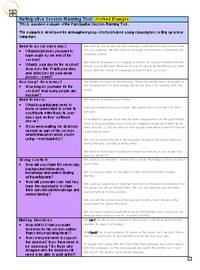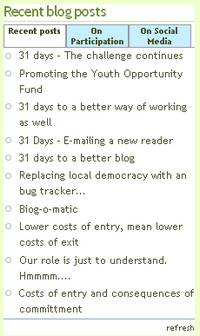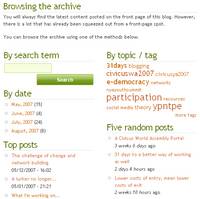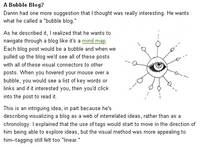I joined the 31-days-to-a-better-blog challenge rather late, but it's already proving amazingly beneficial, not only to this blog – but to my work.
(The 31 Day challenge is a journey in shared learning, drawing upon tasks set by Pro-Logger Darren Rowse – with bloggers brought together by Michele Martin)
I became a freelancer back in April, and since then, I've found myself spending a lot of time working alone on writing and technology projects – not quite managing to make the most of the social aspects of social media. However, after taking the time to e-mail a new reader of the blog, and getting really useful feedback and conversation starters… I realised I need to be more active in involving others in my influencing my work.
So today I've been making more liberal use of quick e-mails to colleagues and conversations in person to get feedback on the new Hear by Right website that's in the pipeline – and its been fantastic to make work feel a lot more social and connected. Plus, I've been able to sneakily ask people to take a look a the blog too in the process to get some extra feedback here… (hello and thanks if this is what's happened to you…!)
Onto catching up with the challenges:
Day 2: Run a first time reader audit
Darren suggests just watching how a new visitor interacts with your blog, before asking them a few questions.
I'll often test out how user friendly my web development work is by watching over the shoulder of a website visitor, or asking others to test out design updates. But I've never tried for a site that is a dedicated blog.
When I visit a new blog, I tend to check if the first few posts interest me, and then if so, I'll hit the RSS feed and subscribe to it. I don't often browse back through the archives, but I do add the blog to a Google Custom Search so that I'll be able to draw upon it at a later date. As I mentioned yesterday I don't often look at that blog again directly, but pick up all I need through google reader.
So it was fascinating to see how my invited visitors, not familiar with website syndication and ways to keep updated with the blog posts, experienced the site.
Liberal use of links across the posts was popular, as was the topics tag cloud. However, I'm aware that for an audience interested in participation or social change (likely to less techie than those interested in the technology sides of my blogging), posts like these about the 31 day challenge can sometimes cause what they would be interested in to slip to far down the page ad get lost. I've shuffled the order of the blocks on the right-hand-side to bring recent blog posts higher up – but I'm wondering whether I should provide options for seeing the most recent blog posts under certain key topics like 'participation', 'technology' and 'social change'. I'm guess fellow 31-day challenger Laura might be right in forseeing categorising blog posts as a future day's task… so I think I'll leave this till then.
One of my new reader auditors (thanks Jake) also pointed out that the Biography Builder I used to put together an extra bio on my about page isn't quite as linguistically adept as it perhaps should be. Jake was left wondering what exactly an interest in "the philosophy of language and cooking" amounts to. Well, I'm just off to cook dinner… so perhaps if I approach it in a suitably reflective way… Erm, anyway, that should have been an interest in "philosophy of language, and cooking".
Other challenges: (up to day 7)
I've joined quite a few new mailing lists lately. I've had to switch to digest mode for most of them, so I just get a daily summary of the conversations as I couldn't keep up – but that often means it's trickier to reply and jump into discussions. So I'll be exploring how I can manage participation in e-mail lists and forums in a more sustainable way (suggestions welcome…)
I'll also sit down tomorrow and see if I can dig out some posts-in-the-pipeline for next week, and work out posting for the rest of August. I'm not looking to have a posting schedule as such – I see this blog as a space to share ideas and information as it arises – not as a daily destination that has to be updated even when there is nothing to say. However, to make sure things do stay current, I'm going to explore whether a linked bit of micro-blogging could help, learning from Laura's Side Notes section.


 thinking on technology, youth participation and social change – the audiences interested in those elements are often quite distinct. I had thought about a 'posts on participation' and 'posts on technology' block for the side-bar, but felt that would be too cluttered… however, thanks to the
thinking on technology, youth participation and social change – the audiences interested in those elements are often quite distinct. I had thought about a 'posts on participation' and 'posts on technology' block for the side-bar, but felt that would be too cluttered… however, thanks to the  As the archive block has moved further down the page in the re-shuffle, I've also added a new
As the archive block has moved further down the page in the re-shuffle, I've also added a new 
 One I've been particularly struggling with is a 1/2 finished post on visualisations. Particularly on ways of taking RSS feeds and managing the information in more visual ways (perhaps in mind-mapped ways like the
One I've been particularly struggling with is a 1/2 finished post on visualisations. Particularly on ways of taking RSS feeds and managing the information in more visual ways (perhaps in mind-mapped ways like the  I'm interested in whether the 31-day-challenge approach could be adopted for organisational learning and change programmes (I'm going to be supporting a number of organisations on learning journeys to engage with social media this autumn) – but I'm worried that this current challenge eats up too much time to fit easily into the work day of busy teams.
I'm interested in whether the 31-day-challenge approach could be adopted for organisational learning and change programmes (I'm going to be supporting a number of organisations on learning journeys to engage with social media this autumn) – but I'm worried that this current challenge eats up too much time to fit easily into the work day of busy teams.
